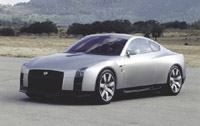Current car style: not what you expect to see at Tokyo show

New car star – what they are? Far-from-common cars chosen by the Japanese "Big Three" automakers' top executives to drive on to the stage at the Tokyo Motor Show Wednesday said it all.
Nissan Chief Executive Carlos Ghosn rolled out in the GT-R, a flagship muscle car. Toyota President Katsuaki Watanabe scooted out in a wheelchair-like "personal mobility" vehicle. Honda President Takeo Fukui chose a rubbery bubble-shaped fuel-cell model.
As starkly different as they may be, the tiny fuel-efficient cars and the expensive sports car are the undisputed stars of the Tokyo Motor Show. Similar offerings, spotted everywhere at a sprawling hall, shed light on how global automakers are hoping to woo buyers in mature markets such as the U.S., Europe and Japan - by appealing to their conscience about the environment and to their passion for speed.
Nissan General Manager Francois Bancon hopes the show will entice interest in cars, which he said was fading not only in Japan but also in Europe, especially among young people. "They are somehow rejecting the car as an icon," he told The Associated Press.
Christopher J. Richter, analyst with Calyon Capital Markets Asia in Tokyo, said Japanese are not only buying fewer cars but also holding on to them longer.
"The decline in personal incomes particularly among young people has had a negative impact on the vehicle market," he said.
Tokyo is notoriously unfriendly to car-owners, with expensive taxes and parking fees. And most urban-dwellers use commuter trains. The growing gap between the rich and poor here has also hurt car sales, analysts say.
Last year, Japan's passenger car sales totaled about 3 million vehicles, down around 7 percent from the previous year.
Automakers say they hope the razzle-dazzle of the more than 500 models on display in this Tokyo suburb, from the jet-like GT-R to the futuristic electric cars, will perk public interest in cars and help revive the lagging sales.
Reporters got a preview look Wednesday at the biannual event, which is opening to the public Saturday.
The 7.8 million yen (US$68,000; EUR48,000) GT-R from Nissan Motor Co., unveiled last week with much fanfare, is a rare offering from the Japanese, more reputed for small cars with solid mileage than the GT-R's twin turbo engine and carbon-fiber components.
The GT-R is being promised for under US$80,000 in the U.S. next year. They go on sale in Japan in December. Ghosn said the company has received orders worth three months of production and plans to sell 1,000 GT-Rs a month.
Fancy sports cars like the GT-R are crucial for enhancing an automaker's image, but environmentally friendly technology that eases consumer conscience about being green is another image-booster.
Honda Motor Co. combined the allure of both in the sleek CR-Z gas-electric hybrid sports car, which President Fukui said outdid rivals with its new hybrid system.
Hybrid vehicles tend to be bulky because of the size and complexity of the hybrid systems, which include a battery, motor and engine. They're usually not known for their torque, acceleration, handling and innovative design.
Fukui didn't say when the CR-Z will go on sale but promised it for "the near future."
"As a leader in ecology, Honda also hopes to show the fun of driving so that mobility can be enjoyed on this planet forever," he told the crowd gathered at the Honda booth.
Besides the scooter-like I-Real, which President Watanabe rode onstage, Toyota Motor Corp. showed a stripped down experimental version of its popular Prius gas-electric hybrid.
Watanabe said the upgrade will be a plug-in hybrid, which can travel longer as an electric car by recharging from a household socket, and will offer double the mileage of the current Prius.
"Our theme is harmonious driving," Watanabe said. "What we have on display shows the direction of where Toyota is going."
Japan has long been an elusive market for the U.S. "Big Three" - General Motors Corp., Ford Motor Co. and Chrysler LLC - whose combined sales make up about 1 percent of the Japanese market.
The top executives of the U.S. automakers skipped the Tokyo show. GM, which had one of the smallest booths at the show, showed only a handful of vehicles, including a Cadillac luxury model.
Upbeat, by contrast, was Lamborghini, which is doing booming business among Japan's burgeoning upper class. Annual sales jumped from just 30 in 2002, to 150 or 160 forecast for this year.
The top-of-the line Lamborghini costs 34 million yen (US$298,000; EUR209,000), but a Japanese customer has bought even the EUR1 million limited-edition model, Carlo Zambotto, representative at Lamborghini Japan, said in an interview on the sidelines of the show.
"The more money it takes, the better it goes - strange as it may sound," he said of the auto market here.
Subscribe to Pravda.Ru Telegram channel, Facebook, RSS!


